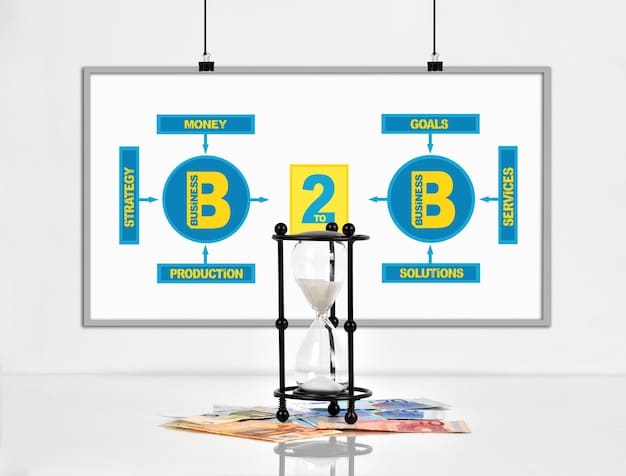Tax Credits vs. Tax Deductions: Maximize Savings in 2025

Tax credits directly reduce your tax liability, offering a dollar-for-dollar reduction, while tax deductions lower your taxable income, potentially resulting in tax savings based on your tax bracket; understanding the difference is crucial for maximizing savings in 2025 tax planning.
Navigating the world of taxes can feel overwhelming, especially when trying to understand the difference between tax credits vs. tax deductions: understanding the difference and maximizing your savings in 2025. But don’t worry, we’re here to break it down and help you make the most of your tax planning.
Understanding the Basics of Tax Credits and Deductions
Tax season can be stressful, but understanding the fundamental differences between tax credits and deductions is the first step towards effective tax planning. Both are valuable tools that can significantly reduce your tax burden, but they work in different ways.
What are Tax Credits?
Tax credits are like coupons from the government. They directly reduce the amount of tax you owe, dollar for dollar. This means a $1,000 tax credit reduces your tax bill by $1,000.
What are Tax Deductions?
Tax deductions, on the other hand, reduce your taxable income. The amount you save depends on your tax bracket. For example, if you’re in the 22% tax bracket and you have a $1,000 deduction, you’ll save $220 in taxes.
- Direct Impact: Tax credits directly reduce your tax liability.
- Income Reduction: Tax deductions reduce the amount of income that is subject to tax.
- Dollar Value: A tax credit of $X will reduce your taxes by exactly $X, which is not the case with deductions.
In summary, tax credits offer a direct and more impactful way to reduce your tax liability, whereas deductions offer a reduction based on your marginal tax bracket. Knowing the difference is essential for strategic tax planning.
Key Differences Between Tax Credits and Tax Deductions
While both tax credits and deductions are designed to ease your tax burden, their mechanics and benefits differ significantly. Understanding these nuances can help you strategically plan and optimize your tax returns.
The primary difference lies in how they affect your tax bill. A tax credit reduces the amount of tax you owe, while a tax deduction lowers your taxable income. Let’s delve into specific distinctions.
Tax Credit: reduces your tax liability, dollar for dollar
Tax Deduction: reduces taxable income. Value depends on your tax bracket.
- Impact on Tax Bill: Tax credits provide an immediate and direct reduction in your tax owed.
- Impact on Taxable Income: Deductions lower the amount of your income that is subject to taxes.
- Who Benefits Most: Generally, tax credits favor those with lower incomes, while deductions may be more advantageous for those in higher tax brackets.

In conclusion, the value of credits and deductions varies based on individual financial situations, so careful planning is necessary. Tax credits generally offer a higher and more immediate value, while tax deductions can be more beneficial for those in higher income brackets.
Common Types of Tax Credits Available in the US
Tax credits can provide substantial savings if you know which ones you’re eligible for. The US government offers a variety of credits aimed at encouraging specific behaviors or providing relief to certain groups.
These are some of the most common tax credits available that may reduce your tax burden.
Child Tax Credit
This credit provides financial relief for families with qualifying children. The amount can change each year, so it’s essential to stay updated on the specific regulations.
Earned Income Tax Credit (EITC)
The EITC is designed for low-to-moderate income individuals and families. It can significantly reduce the amount of tax owed and may even result in a refund.
American Opportunity Tax Credit (AOTC) and Lifetime Learning Credit
These education credits help offset the costs of higher education. The AOTC is for the first four years of college, while the Lifetime Learning Credit is for any education expenses.
- Research: Stay informed of any new credits of changes to current laws.
- Eligibility: Make sure you meet all the requirements to properly claim a specific credit.
- Consult a Professional: Consult with a tax professional if you are unsure which credits you may qualify for.
Many of the available tax credits are aimed at specific situations and groups, therefore, it is crucial to conduct thorough research to determine which credits are applicable and beneficial to your financial affairs.
Popular Tax Deductions You Should Know About
Tax deductions reduce your taxable income, which can lower your overall tax liability. There are various deductions available, and the right ones for you will depend on your individual circumstances.
Understanding these common deductions is vital for maximizing your return.
Standard vs. Itemized Deductions
You can choose to take the standard deduction, which is a fixed amount based on your filing status, or itemize your deductions if they exceed the standard deduction.
Mortgage Interest Deduction
Homeowners can deduct the interest they pay on their mortgage, which can significantly reduce their tax bill.
Charitable Contributions
Donations to qualified charitable organizations are tax-deductible. Make sure to keep records of your donations for verification.

- Record Keeping: Keep track of all receipts and documents relating to any deductions you plan to claim.
- Compare Options: Evaluate whether taking the standard deduction or itemizing will result in the lower tax bill.
- Consult a Professional: Always seek the advice of a professional when making critical financial, tax, or investment decisions.
Knowing which deductions you can claim is essential for effectively reducing your taxable income. Keep the proper records, assess whether to itemize or take the standard deduction, and consult a trusted tax professional with any further questions.
How to Strategically Combine Credits and Deductions
To optimize your tax strategy for 2025, it’s essential to understand how tax credits and deductions can work together. While they function differently, leveraging both can result in significant tax savings.
Strategic planning can help you maximize your savings by combining them effectively.
Maximize Credits First
Since credits provide a dollar-for-dollar reduction in your tax liability, focus on maximizing these first. Ensure you’re taking advantage of all credits you’re eligible for.
Use Deductions to Lower Taxable Income
After maximizing your credits, use deductions to lower your taxable income. This can further reduce your tax liability, especially if you’re in a higher tax bracket.
Consider Tax Planning Software
Tax planning software can help you simulate different scenarios and determine the best combination of credits and deductions for your individual situation.
A strategic approach to combining credits and deductions can result in maximum tax savings. To optimize this, it is best to determine all available credits, use deductions to lower taxable income, and consider using tax planning software.
Planning for 2025: Anticipated Changes and Opportunities
Tax laws and regulations are always subject to change, so it’s crucial to stay informed about potential updates that could impact your tax planning for 2025. Anticipating these changes can help you make informed decisions and take advantage of new opportunities.
Staying on top of these developments is vital for compliant and effective tax management.
- Legislative Updates: Keep an eye on any legislative changes that could affect tax credits and deductions.
- Consult a Professional: Seek advice from tax professionals who are up-to-date on the latest regulations.
- Tax Planning: Take time to plan your tax strategy based on anticipated changes.
Planning for 2025 requires staying informed about any potential changes in tax laws and regulations to strategically optimize tax benefits. Make sure to consult with tax professionals to stay up to date.
| Key Point | Brief Description |
|---|---|
| 💰 Tax Credits | Directly reduce your tax bill, dollar for dollar. |
| 📉 Tax Deductions | Lower your taxable income; savings depend on your tax bracket. |
| 👨👩👧Child Tax Credit | Financial relief for families with qualifying children. Keep updated with regulations per year. |
| 🤝 EITC | Earned Income Tax Credit; designed for low-to-moderate income individuals and families. |
Frequently Asked Questions
▼
A tax credit reduces your tax bill directly, dollar for dollar. A tax deduction, on the other hand, reduces your taxable income, which in turn lowers the amount of tax you owe.
▼
Generally, a tax credit is more valuable because it directly reduces the amount of tax you owe. The value of a tax deduction, however, depends your tax bracket.
▼
Eligibility for tax credits and deductions depends on various factors, such as income, family status, and expenses. Review IRS guidelines and requirements and consider speaking with a professional.
▼
Yes, you can claim both tax credits and tax deductions. Often, they can be combined strategically to maximize your tax savings. Be sure to check eligibility requirements for each one.
▼
Stay informed by monitoring the IRS website, consulting with tax professionals, and reviewing reputable financial news outlets. Staying on top of this information will allow you to optimize savings.
Conclusion
Understanding the nuances between tax credits and tax deductions is crucial for effective tax planning. By strategically leveraging both, staying informed, and consulting with professionals, you can maximize your tax savings in 2025 and beyond.





